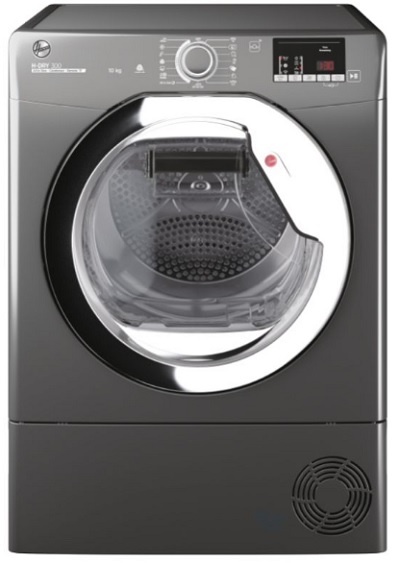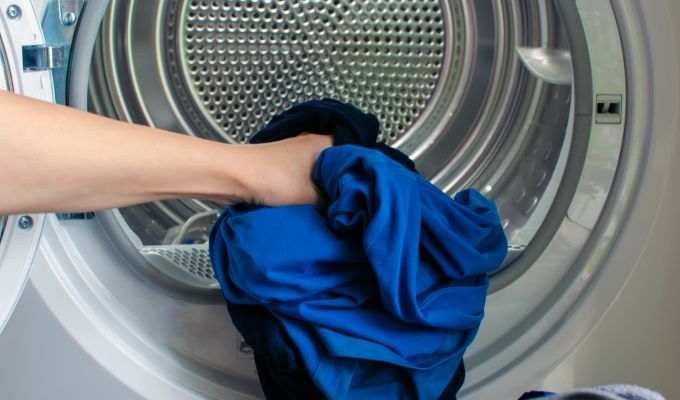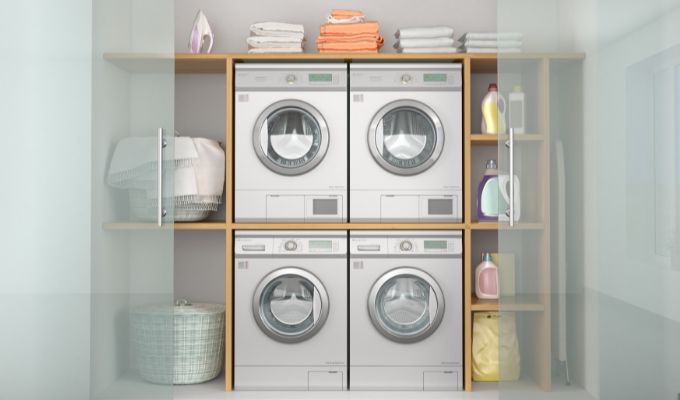When it comes to switching to environmentally friendly and energy-efficient household appliances, the heat pump tumble dryer tops the list. These appliances are relatively new to the UK market, first gaining popularity across Europe.
If you’ve only just discovered them you may be wondering how they work. Let’s walk through the ins and outs of heat pump dryers, as well as the technological foundations upon which they are built.
What are Heat Pump Tumble Dryers?

The heat pump dryer is an evolution of the well-known condenser dryer. Both dryers operate on the “drying laundry with condensation” principle. Heat pump dryers, on the other hand, use more complex and energy-saving technologies.
Unlike traditional condenser dryers, heat pump dryers use a heat pump and closed circuit rather than a heating element and vent.
Dryers with a heat pump are efficient and cost less to run than conventional dryers, plus they don’t require a vent. The dryer uses the same air to heat, cool, and condense all within the same unit.
In the same way as an air-source heat pump has a closed circuit of refrigerant pipes and two sets of coils, an evaporator (cold) and a condenser (hot), a heat pump dryer has these same components (hot).
The air is heated by the condenser coils and then circulated through the drum, where it becomes hot and dry. After leaving the drum, the warm, humid air is pushed over the evaporator coils, where the air is cooled and the moisture is condensed out.
Moisture evaporates or accumulates in a tray that may be removed and emptied. When the drum is empty, the condenser coils heat the air and blow hot, dry air back into it.
It sounds complex, and it is compared to a traditional vented tumble dryer, which is basically like a box with a heater and fan that blows your clothes dry. Heat pump dryers are more sophisticated and work like a refrigerator, except in reverse.
If you can imagine the refrigerator in your kitchen – it cools and freezes food, but this process also creates heat. You can feel the heat across the heating element at the back of the fridge, Well, heat pump dryers utilise the byproduct of heat from cooling as a way to form warm air for drying.
The benefit of this heat pump function over a standard condenser drier is that the air is not solely heated by a heating element. Warm air is not drawn to cold air from the outside during the heat exchange.
As a result, the standard condenser drier wastes energy and raises the ambient temperature. The heat pump dryer, on the other hand, operates on a closed heat circuit and is thus far more energy-efficient and, in some cases, quieter.
How Heat Pump Tumble Dryers Get Rid Of Water
There are three types of tumble dryer – vented, condenser, and heat pump. Now, all of these dryers work in much the same way, by tumbling clothes around inside a drum. The drum circulates warm air, which helps to dry fabrics, and the moist air is expelled by different means.
Heat pump dryers are more energy-efficient, and with rising fuel costs, this would be your pick for saving money on electricity bills.
Let’s take a look at how heat pump dryers work, in comparison to vented and condenser dryers.
Vented Dryers

We’ll start by discussing the original, and most common tumble dryer type – vented.
The way these dryer works is quite simple, making them the cheapest style of dryer you can buy.
Vented tumble dryers draw in air that is heated by an electrical heating element, blown through the laundry to extract moisture from fabrics, then the humid air is sent outside the building through exhaust ducting or piping.
The exhaust air hose should not be less than 10cm wide to limit any back pressure, so the system needs to be set up correctly for the dryer to work efficiently. To discharge the exhaust air outside, the hose either needs a separate vent through a wall, open window or door.
The only real drawback of these dryers is that they need to be used where there is good external ventilation, which can be tricky in flat and small homes.
Condenser Dryers

The condenser dryer differs from the exhaust air dryer in that the airflow for drying the laundry circulates in a largely closed circuit, eliminating the need for external ventilation.
The warm, moist air from the drum first passes through a lint filter, then through a condenser that cools the air to create condensation. The condensed water is then collected in a built-in water tank.
Thanks to this largely closed air circuit, the condenser dryer does not need a vented exhaust air hose and is therefore more can be stored in large cupboards, or rooms will little ventilation.
The condenser draws air from the installation room for cooling. The heat gained is released back
Because condenser dryers blow warm air back into the room, in winter, this can be helpful as a way to heat your home. In summer, however, it can be very uncomfortable running this type of dryer. And during the warm summer months, because condenser dryers work better when the room temperature is cooler, the dryer needs to work harder and is less energy efficient compared to vented dryers.
Heat Pump Dryers

Now heat pump dryers are not affected by the ambient air temperature, because there work in a closed air system that refrigerates and heats the air as required, for optimal drying performance.
Here’s how it works: There is no heating element, instead, air is drawn into the system and is heated by compressing Freon gas in a closed circuit. This heated air is then pumped into the spinning drum where it meats clothes, extracting moisture and creating a water vapour.
Moist air is then pumped out of the drum and down into a heat exchanger, where it’s cooled by a refrigerated element, forming condensed water droplets on plates.
After removing the moisture from the air, the air then flows through a heater where it’s re-heated and pumped back into the drum, and the drying cycle continues.
So where does the moisture go? With heat pump dryers, extracted moisture gets either pumped into a water reservoir tank, where you can empty it when it’s full, or you can plump this machine into your home’s drain pipework, just the same as you can with a washing machine or dishwasher.
The heat pump itself is driven by a small electric motor. The energy savings result from the fact that the power consumption of the motor is less than the heat output generated. In addition, no energy is lost. As a result, the heat pump dryer requires around 50% less electricity compared to a conventional condensation dryer and isn’t affected by fluctuating room temperatures.
Further, this heat pump system is much more robust and has a longer life expectance over vented and condenser models.
While the vented air dryers are not as popular these days, most people opt for condenser dryers, as these dominate the market with much greater range and availability. But the tumble dryer with a heat pump is a better system, although, more expensive (expect to pay £500 or more for a good one), it will pay for itself in lower energy consumption and fewer repairs.
Heat Pump Dryer FAQ’s
How to care for a heat pump dryer?
Condensation dryers and heat pump dryers have a lint filter and an onboard condensed water tank. The dryer can only work efficiently if both are emptied and cleaned regularly. Typically, you’ll find the condensed water container is located in a pull-out drawer on the top left of the dryer. The lint filter can be pulled out at the lower edge of the drum when the door is open.
Do Siemens and AEG heat pump dryers have differences?
These tech brands have an excellent range of heat pump dryers. With regard to the basic functionality of AEG or Siemens heat pump dryers, we cannot tell you any noteworthy differences, they do much the same job. Almost all heat pump dryers from well-known manufacturers of household appliances will achieve comparable results.
Miele and Bosch have a range of premium heat pump dryers, and like Siemens and AEG, they all do the same job. However, some of the energy ratings may differ, so if you’re switching to heat pumps primarily for the eco-benefits, then compare energy ratings before purchase.
Aside from energy running costs, look at program features, dimensions and machine aesthetics to make your final decision.
How to connect the heat pump dryer to drain?
In terms of functionality, a heat pump dryer with a drain hose has the advantage that there is no need to empty the condensate container, which means minimal maintenance. It’s very simple to connect the hose, providing you have a connection to the drainpipe under the sink. It’s connected in the same way a washing machine hose connected to the plumbing.
If you already have dishwasher and washing machine drain hoses plumbed in you may not have space from the heat pump hose, which will require some adaptations to be made to the pipework.
The best way to proceed when connecting the heat pump dryer to the water drain can be found in the manufacturer’s instructions, as there are differences between the various brands.
How Long is a Heat Pump Drying cycle?
Tumble dryers with heat pumps take substantially longer to dry. Depending on how much washing you put in and how wet it is, a drying cycle can take 1 to 2 hours when it’s dry enough to store away.
The drying cycle in a heat pump dryer takes longer than traditional dryers because it drys with less heat.
How Heat Pump Dryers Compare to Condenser and Vented
Electric tumble dryers come in three distinct configurations: vented, condenser, and heat pump. Vented tumble dryers draw air from the environment and warm it using an internal heating element.
This warm air is then blown into a rotating drum where it removes moisture from fabrics, then the air is blown through a wide hose to the outside of the building.
In condensation dryers, the warm, moist process air is cooled by passing through a heat exchanger, causing the moisture to condense as condensation and is collected as excess water in an onboard tank.
Heat pump dryers function similarly to condensation dryers, with the exception that an incorporated heat pump turns the heat created back into energy. A heat pump can be run in an entirely closed circuit.
This saves electricity and reduces energy bills. Furthermore, the warmth of the room in which the tumble dryer is situated is minimal, and the drying temperature is in the low-temperature range, which is gentle on the laundry.
Advantages of Heat Pump Dryers
Heat pump dryers provide numerous advantages. The benefits of a heat pump dryer are obvious as they use substantially less energy than vented air or condensation dryers. As a result, heat pump dryers are typically classified as in the A to A+++ range in terms of energy efficiency.
Depending on the model, power savings of up to 50% are possible when compared to an equivalent condenser or vented dryer. This is a quantum leap that can save money and presents a compelling case for eventually replacing obsolete dryers.
In theory, the heat pump dryer can be placed in any room of the house. The moisture recovered from the clothes is not released into the room. Instead, the moisture is collected in a container after remaining in a closed circuit, so there’s less possibility of condensation on walls and windows.
Disadvantages of Heat Pump
Heat pump dryers have no technical disadvantages when compared to conventional dryers. So far, the sole negative is increased acquisition cost for the machine, but this will eventually pay for itself with the saving in power usage.
Most devices that operate on the heat pump principle require slightly longer drying durations. Because it does not use high temperatures, drying times can be up to twice as long.



